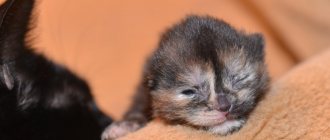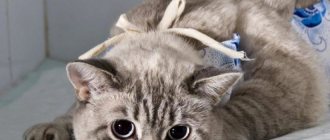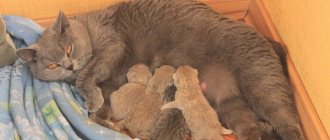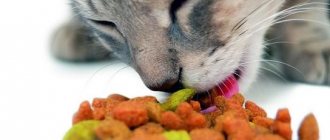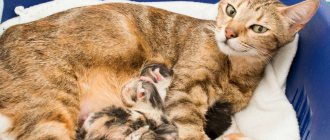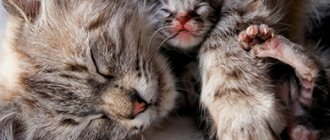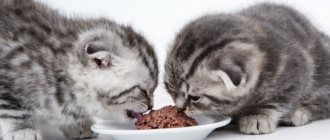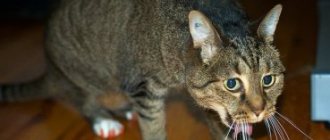General information about the needs of a pregnant cat
Any animal that has reached sexual maturity begins to look for a mate. If a person does not interfere with this process, 2 months after mating the pet’s babies are born. For owners of elite cats, this is a business, so it is very important to maintain the health of the cat so that the offspring are viable and meet the requirements of the breed.
Pregnancy is a special challenge for any living creature. The body undergoes changes affecting not only the genital organs, but also other vital systems. To provide the pregnant woman and her offspring with nutrients, the body begins to produce double the amount of blood. The formation of babies increases the costs of the mother's body. The expectant mother needs proteins, carbohydrates and minerals.
During pregnancy, the cat's body experiences a lack of vitamins and suffers from excessive stress and toxicosis. Therefore, you should take care of the correct diet during this period. The cat's character and taste preferences may change. This should also be taken into account when choosing products.
After the birth of babies, some cats experience postpartum eclampsia, accompanied by a sharp drop in calcium and sugar in the body. In the absence of qualified help, the cat may die along with its offspring.
During labor, the animal’s body is exhausted and dehydrated, so it is necessary to provide water near the lambing site. Some cats ask to eat before giving birth, others refuse food. There is no need to force-feed, and overfeeding is also not recommended to make labor go faster.
About 5-6 hours before contractions, the cat stops eating. An empty stomach promotes the proper process of delivery. If your pet is hungry and asks for food, you need to offer her some low-fat cottage cheese.
The first days after the birth of babies, the cat feeds them colostrum. This product establishes the correct microflora in the intestines of kittens. After this, the babies are ready to be fed full-fledged mother's milk.
What to give a cat to increase lactation?
To make your cat produce more milk, there are effective and harmless natural remedies. Here are some of them:
⦁ Infusion of walnuts with milk. To prepare this infusion, you need to put 8 - 10 peeled nuts in a thermos, pour 0.5 liters of boiling milk over them and leave for up to 4 hours. You need to add a little sour cream to this infusion and let it turn sour. The result is a very tasty yogurt that your pets really like. To strengthen the strength of the cat’s body after the release of colostrum, you can add two to three quail eggs, one to two teaspoons of glucose, and one tablet of medical yeast to this mixture.
⦁ Powdered nettle inflorescences are added little by little to cat food.
⦁ A decoction of wild raspberry leaves not only increases lactation, but also helps expel parasites, which is very important for nursing cats.
⦁ Green oat grass stimulates lactation, improves immunity and strengthens the animal’s body.
⦁ Infusion of lemon balm leaves in milk increases the quantity and quality of milk.
⦁ Herbs that increase milk production also include fennel, cumin, primrose, sweet clover, carrots, dandelion, and yarrow. You can make decoctions and infusions from them and give them to cats.
In addition, to increase milk supply, the cat needs rest, plenty of fluids and a balanced diet.
Nutrition before birth
If mating occurs under human control, the correct diet is thought out already at this stage. The health of future kittens depends on how complete the pet’s food was. Cats, left to their own devices, walk in the yard, so it is impossible to control the process of conception. Owners of such pets will know about pregnancy by their rounded sides.
This happens in the second half of pregnancy, so the diet has to be strengthened upon detection. The animal needs an additional vitamin diet enriched with calcium and proteins. It is recommended to show the cat to a veterinarian, he will assess the state of health and prescribe the necessary vitamins.
If there is a cat living in the house that walks outside on its own, it is better to take care of the issue of the appearance of kittens in advance. Regularly looking for a home for children is not a pleasant task. Veterinarians recommend spaying cats before their first heat. This will avoid the hassle of childbirth and numerous offspring. Pets usually make their owners happy with 6-8 babies, and they do this with enviable regularity.
An incorrectly designed menu can lead to developmental delays in children:
- a lack of minerals will certainly affect the structure of bones; children may suffer from rickets;
- imbalance of salt metabolism provokes dental problems;
- vitamin deficiency causes developmental defects;
- If there is insufficient intake of amino acids and proteins into the cat's body, pregnancy can end in miscarriage.
It is very important to monitor the nutrition of the expectant mother 1 month after fertilization. During this period, there is an active process of formation of internal organs and systems of embryos.
The diet of a pregnant cat should consist of the following products:
- Meat (chicken, turkey, beef) is best used boiled. When consuming raw meat products, there is a high risk of becoming infected with worms. If the cat only requires a raw product, it must be kept in the freezer for at least 2 weeks. This neutralizes germs and worms.
- Fish is also used boiled. Fish dishes should be present in the diet no more than once a week.
- Milk causes intestinal upset in some cats, so it is recommended to replace it with kefir, cottage cheese, yogurt or fermented baked milk. Natural calcium contained in dairy products is necessary for the proper formation of the skeletal system and teeth. An excess of calcium is just as harmful as a deficiency. If animals are overfed with fermented milk products, they are prone to constipation, the functioning of the heart and kidneys is impaired, which leads to a deterioration in the cat’s health and jeopardizes the process of delivery.
An example of a natural menu for a pregnant cat whose weight before conception was 3 kg:
- meat – 120-150 g, closer to the middle of pregnancy the norm increases to 200 g;
- fermented milk products or milk – 50 g;
- vegetables or green grass – 50-80 g;
- chicken yolk – once every 7 days;
- boiled fish - no more than once a week.
Your veterinarian may recommend the use of minerals and vitamins to supplement the diet.
If the cat is accustomed to dry industrial food, it is transferred to a premium diet specially designed for pregnant women. The amount of feed is determined according to the instructions and standards specified on the manufacturer’s label.
The menu of a pregnant pet should not include:
- smoked products, even if it is meat or fish;
- salted fish, canned food;
- cheap minced meat or sausage;
- bones;
- sweets and baked goods.
What feed is best to use?
Ready-made food can make life easier for owners of nursing cats, eliminating the need to count the amount of proteins and carbohydrates in their pets’ diet. However, during lactation you need to take special care with dry food and carefully study the information on the packaging.
Firstly, the food must be made from high-quality components that are biologically appropriate for the cat’s body. Secondly, it must have a balanced composition, ensuring good quality milk for kittens. And thirdly, if a cat ate natural food before giving birth, then you definitely shouldn’t switch it to dry food during lactation, even the best one. This will be stressful for her digestive system and the whole body. If during pregnancy she ate high-quality dry food, then you can continue to give it, if possible alternating with wet food from the same manufacturer.
Wet food is the most suitable food for a nursing cat.
When feeding with prepared food, wet food is preferable to dry food, provided the composition is of high quality. The fact is that dry food requires a lot of liquid to digest, and the cat’s body needs it to produce milk. Therefore, feeding dry food can lead to a decrease in lactation.
Ready-made feed
Some manufacturers have special product lines for pregnant and lactating cats. If there are none, then you can use any food for kittens. However, the most valuable foods in terms of composition, which can unconditionally be classified as holistic, do not always have varieties for kittens and cats during motherhood. It is assumed that these foods are suitable for any healthy animal in the absence of allergies or individual intolerance to the components. Therefore, for cats during lactation, you can purchase both specialized products and holistic products from well-known brands. This applies to dry food.
There are several types of food for pregnant and lactating cats, the most popular of which is Royal Canin Mother & Babycat
Wet food for nursing cats is very difficult to find, but any canned food for kittens with a good composition (with a predominance of meat, poultry and fish) is suitable.
Table: food for nursing cats
| Name | Type of feed | Main components of the composition | Peculiarities | Price |
| Royal Canin Queen 34 PRO | Dry |
| Maintains normal hormonal levels and the functional state of the uterus, ensures the high-quality composition of milk, and improves immunity. |
|
| Royal Canin Pediatric Queen for pregnant and lactating cats | Dry |
| Formulated specifically for the needs of pregnant and lactating cats, the antioxidant complex helps support natural defenses. |
|
| Royal Canin Mother & Babycat (Russia) | Dry Canned Food |
| The complex of prebiotics and antioxidants in the composition facilitates digestion and improves immunity. |
|
| Eukanuba for kittens, pregnant and lactating cats (Russia, Poland) | Dry |
| Contains moderately fermentable fiber (sugar beet pulp) for healthy digestion, docosahexagenic acid for brain and vision development, Omega-3 and Omega-6 fatty acids. |
|
| Summit holistic for kittens and cats three types of meat with chicken, salmon and turkey (Canada) | Dry |
| A combination of three types of meat, only high-quality ingredients from trusted farms, contains pre- and probiotics, antioxidants, and omega-3 and omega-6 fatty acids, prevents the formation of hairballs in the gastrointestinal tract. |
|
| GO! NATURAL Holistic for kittens and cats with whole chicken, fruits and vegetables, DAILY DEFENCE™ Chicken Cat Recipe (Canada) | Dry |
| Contains pre- and probiotics, antioxidants, as well as omega-3 and omega-6 fatty acids, has a very diverse composition (about 50 components) with a good vitamin and mineral supplement. |
|
Natural food
If the cat eats natural food, then in the first week after birth she is offered the most easily digestible options: fermented milk products (without sugar and low fat), cereals, some vegetables, lean meat and poultry. The meat must be cooked and chopped. Broths are very useful - they are nutritious and replenish fluid loss. The best option is broth made from turkey, beef, or rabbit. Cow's milk is gradually introduced into the diet - if the cat's stomach reacts normally, then you need to give her milk daily. It is a good source of protein and calcium for mother and babies. If you are intolerant to fresh milk, you can try diluting dry milk for your cat - it is more easily absorbed by the body.
It is better to give milk to a cat warm, this has a positive effect on lactation
After a week, the list of products for the mother cat can be expanded, but when introducing new products, carefully monitor the pet’s reaction. The basis of a nursing cat's diet is animal proteins, the healthiest of which are turkey, beef, chicken, sea fish, dairy products and eggs, their share should be about 60% of the daily menu. The remaining 40% comes from carbohydrates (porridge), fats (fish oil and healthy vegetable oils), vegetables (carrots, cauliflower, zucchini, pumpkin, beets), some fruits (apples), fresh grass or sprouted grains as sources of vitamins.
Buckwheat porridge is very useful. It is better to give quail eggs and no more than a couple of times a week. It is recommended to give your cat a teaspoon of bone meal daily as a source of calcium.
Cats are not always ready to eat vegetables and grains, so they need to be chopped and mixed with meat or cooked into a puree soup from several components.
To create a complete menu that includes all the healthy foods for your cat in the right quantities, it is better to contact an animal nutritionist or veterinarian . The average cat owner is unlikely to cope with this.
Natural food cannot fully satisfy a cat’s nutritional needs; the diet must be supplemented with special nutritional supplements.
My cat gave birth once and did it by accident at the respectable age of 11. The pregnancy was not planned. She only had two kittens, and one survived. Of course, one cub sucked much less than several, so the cat ate a little more than usual. However, it was then that she fell in love with milk and especially cream. I didn’t drink before pregnancy, but after giving birth I started drinking with pleasure. She still loves cream very much, especially with 20% fat content. Before giving birth, the cat ate not very proper natural food and wet canned food for cats, and during lactation I fed her mainly boiled chicken and fish and dairy products (yogurt, curds, milk, kefir). I also gave her vitamins, which I myself, without a veterinarian’s recommendation (I confess!), chose from a veterinary pharmacy. I grew her grass from special seeds for cats. She didn’t give me vegetables, she tried porridge, but without much success. Later, wet food was added to the natural food. Everything was fine with the cat and kitten. The kitten has grown into a big and kind cat, much larger than its mother.
Is it possible to mix different types of food?
It is allowed to mix dry and wet food of the same line when feeding cats.
It is not recommended to feed cats natural food and dry food at the same time, since the cat’s digestive system will have to adapt from one type of food to another, and this will negatively affect its functioning.
Mixing natural food and wet food is acceptable, but not advisable, as this will upset the balance of nutrients in the diet.
Feeding and norms by trimester
When compiling a diet, you should take into account the pet’s weight, age and body type:
- In the first trimester, the cat begins to eat intensively; she constantly lacks the usual portion. This is a natural process, so the total volume of products is increased. Within 14 days after conception, the daily diet is increased by approximately 10%. If the cat previously ate 2 times a day, the number of feedings is increased to 4-5 times.
- In the second trimester, the total volume of food is increased by 50%.
- In the third trimester, the cat eats much less than at the beginning of pregnancy. Therefore, the portion can be reduced or divided into 6-7 times. 7 days before the expected date of birth, babies return to standard feeding 2-3 times a day, and the food intake is also reduced.
General recommendations
As soon as they are born, kittens actively latch onto their mother’s breast. Once every couple of hours, on average, they receive a dose of milk, along with it sucking beneficial microelements from the cat’s body. Their supply should be replenished with the help of a special diet - a high content of macronutrients, calcium, magnesium and other microelements.
Until the age of two months, kittens are predominantly fed milk, then the cat begins to drive them away. Before lactation stops, the young mother eats often and in small portions. The main task of such fractional feeding is to provide the body with the necessary substances for the next feeding of kittens.
A prerequisite for any type of feeding (dry or natural) is that liquid (water and broths) is freely available to the animal.
Principles of proper nutrition
There are no global differences from ordinary days during this period. Preference is given to food that is easily digestible, nutritious and corresponds to the increased load. The only deviation from the standard regimen is the need to stimulate milk production.
The calorie content and content of the food should cover the costs of the current gestation and subsequent feeding of kittens and form the basis for the cat’s body for new pregnancies. At the same time, be sure to monitor the incoming amount of food.
A cat's daily diet is based on three variables:
- The pet's own body weight;
- Age;
- Number of kittens in the litter.
Basically, the norm doubles from the pre-pregnancy level.
Changes in the hormonal background of the nurse can also affect taste preferences. Don’t worry if your beauty begins to refuse her usual food. It is worth changing the set of components if it is natural food, or purchasing dry food from another manufacturer.
A variety of foods will also help support the new mother’s appetite. At first, the diet is supplemented with dairy products, vegetables, cereals and boiled lean meat. Then gradually the amount of introduced components, especially milk, decreases, and only the usual components remain in the diet.
It is important to monitor the level of microelements entering the cat’s body. A deficiency of calcium and magnesium, for example, can turn into a disaster - the pet’s coat, teeth and joints suffer.
The criterion for a well-chosen diet will be the condition of the cat upon completion of feeding: the constitution of the animal and the quality of the coat should be the same as before pregnancy.
Nutrition after the birth of babies
Refusal to eat in the first 5-6 hours after lambing is considered normal. It is necessary to control that the animal continues to drink, otherwise the cat will weaken before our eyes from dehydration. It is necessary to offer warm milk, low-fat meat broth, kefir diluted with warm water. You can add a little salt and sugar to the water to restore the body's natural needs.
Regidron solution is a good remedy recommended by experts for dehydration. Therefore, even during pregnancy, it is necessary to purchase it at the pharmacy.
Refusal to drink water is an alarming sign. Body temperature must be measured. A high indicator against the background of dehydration may indicate eclampsia. The condition is dangerously fatal, so you should immediately consult a veterinarian.
Diet of a nursing cat
Balanced feeds intended for lambing animals are available for sale. If your cat is accustomed to dry food, you can purchase premium food. Manufacturers have taken care of the balance of this food and its usefulness. In addition, the feed has special additives that stimulate lactation. They contain an increased content of vitamins and proteins necessary for adequate nutrition of newborn kittens.
If the cat was on a natural diet before pregnancy, it continues to be fed with its usual foods. For the first 2-3 days, the food should be liquid or soft enough so that the pet can eat lunch without effort. For example, meat is boiled and ground in a blender, then diluted with a small amount of broth.
Feeding kittens with colostrum requires adding warm dairy or fermented milk products to the cat's diet. To stimulate the cat's appetite, food must be offered warmed.
After the birth of the offspring, the cat is fed in small portions, the number of feedings is increased to 5 times a day. The diet consists of meat and vegetable dishes, a small amount of buckwheat and rice porridge, milk, kefir, and cottage cheese. Fish and eggs are given occasionally. Chicken eggs are replaced with boiled quail eggs.
Diet
Why does a cat vomit after dry food?
For the first 4-5 hours after giving birth, the cat will refuse to eat. She needs to be offered warm water and milk.
Meat products
Immediately after childbirth, you can introduce a small amount of boiled dietary meat (turkey, rabbit) into your diet. From the 14th day, when the pet has fully recovered, the usual food is given. Including meat in any form.
Dairy
Dairy products are necessary after childbirth. What to feed a newborn cat:
- milk;
- cottage cheese;
- sour cream;
- curdled milk;
- fermented baked milk;
- kefir
Dairy products saturate the body with beneficial elements
Important! Dairy products must be present on the menu throughout lactation and 20-30 days after its end. After this, if the cat refuses, you can eliminate milk from the diet.
Bone flour
Contains calcium, which is necessary for the animal during the postpartum period. If there is a lack of it, the cat feels unwell, convulsions and eclampsia may occur. Such pathological conditions often lead to death. Bone meal should be given 1 tsp. daily. The Scottish Fold especially needs this so that the ears take the correct position.
Fish
Fish is necessary for a cat who has given birth, but not more than several times a month. It is better to give preference to low-fat varieties. What fish to feed a nursing cat:
- hake;
- halibut;
- cod, etc.
The fish must first be cleaned of bones.
Broths
Warm broth improves the functioning of the gastrointestinal tract. It can be prepared from chicken, turkey, beef, cereals and vegetables, but without spices and salt.
Special dry food
For the first time after giving birth, it is not recommended to give your pet a ready-made dry diet. It contains virtually no moisture and adversely affects milk production. In addition, the food contains a lot of heavy salts, which is bad for growing kittens.
The only exceptions are purebred cats (for example, British cats). If before giving birth the pet ate dry food, changing the diet is undesirable.
When the product is not digestible, you can switch to canned food from the same manufacturer
Eating for more milk
You can ask your veterinarian what to feed a cat that has given birth to kittens to produce milk. He will give the necessary recommendations based on the individual characteristics of the animal.
Often, to improve lactation, a cat is given a decoction of lemon balm, oregano and anise, 1 tsp each. in the morning and in the evening. It should be slightly concentrated: 1 tsp. dried grass is poured with 500-600 ml of water.
Attention! Before giving the animal a decoction, you need to try it yourself. If it tastes bitter, you need to add a little sugar. Otherwise the cat will refuse him.
Eating after childbirth
During pregnancy, each kitten is formed in an individual pouch. This afterbirth leaves the body with or after the baby. If the kitten was born in the afterbirth, the cat chews the bubble, freeing the baby. The mother actively licks the kitten, clearing the airways of mucus and stimulating the opening of the lungs. The afterbirth contains vitamins, proteins, and moisture, which is why many cats eat the amniotic sac.
Some breeders recommend limiting the pet by not allowing it to eat the afterbirth. There is nothing dangerous about a cat eating amniotic sacs. The only thing is that if there are a lot of kittens, then eating so many afterbirths can result in indigestion for your pet. It is enough to give your cat an unsweetened solution of Enterosgel to drink so that all digestive problems disappear.
Danger of exhaustion
After the babies are born, the cat loses a lot of weight. If you do not support her body with additional nutrition at this moment, exhaustion may develop. This often happens during multiple pregnancies. Pets can give birth to 6-8 or even more kittens. This is fraught with severe stress for the body.
Babies need nutrition, and the body is not able to produce the required amount of milk. Therefore, owners should not only feed the cat, but also provide feeding for newborns.
In a multiple litter there will always be 2-3 babies who lack maternal nutrition. At birth, they are weak and low in weight, which affects their further development. Such kittens are pushed away from the nipples by their more agile brothers.
In order for babies to get food, the feeding process must be under the control of the owner. Experts recommend weighing each baby and recording the data on an observation sheet. This will help control weight gain.
Supplementary feeding for weakened babies may be the only salvation. Diluted goat's or cow's milk is used as food. You can use baby formula, but it is best to purchase special food at a pet store.
It is also useful to feed your cat special baby food. If infant formula is used for supplementary feeding, you must read the instructions and composition of the product. Baby formulas are made with added fruit and sugar, but cats do not need this.
Kittens, like humans, can suffer from food allergies. When supplementary feeding is introduced, it is necessary to conduct a daily inspection for skin reactions and lacrimation.
Exhaustion in a cat can occur if kittens are breastfed for too long. About 1 month after birth, kittens’ stomachs are ready to explore new foods. If the kittens are naturally fed, boiled chopped meat and dairy products are introduced into the diet.
Features of cat nutrition in the first days after birth
The nutrition of a cat after giving birth that will feed babies must be correct, nutritious, and free of chemical additives and harmful substances. The diet is chosen individually for each representative, depending on the course of pregnancy, well-being after and the physical characteristics of the body. Such points as premature birth or post-term pregnancy, birth with surgical intervention, the presence of diseases during pregnancy and other cases will be taken into account. If the birth was natural and easy, then you can create the diet yourself, but it is always better to consult with a veterinarian. In any case, you need to remember the rules of the diet of a cat who has given birth:
- Carbohydrates must be supplied to the cat's body with food. The substance should be easily digestible and make up approximately 40% of the total diet. Protein should make up approximately 35% of the total diet.
- Your cat needs to drink plenty of fluids to help produce milk.
- Fatty, salty, spicy foods are excluded. Spicy foods should be excluded at any time in the animal's life.
- The pet should be fed 4-5 times a day in small portions.
The diet should contain a lot of protein
Food should contain substances such as magnesium, potassium, zinc, phosphorus, and iron. To restore the body after childbirth, vitamins A, D3, C, as well as a complex of B vitamins contribute. Kittens, as well as cats, will benefit from arginine, taurine, folic acid, beta-carotene and L-carnitine.
Important microelements should be supplied with food
Immediately after the birth of kittens, cats eat the placenta. The placenta, or placenta, is an embryonic organ that all female mammals have during pregnancy. It comes out during birth at the same time as the kittens. And often, on an intuitive level, the cat eats them. The organ has a number of vitamins and nutrients. There is nothing wrong with eating it, but if a cat eats more than two afterbirths, stomach problems may begin. Therefore, this moment should be controlled.
Cats eat the placenta, an organ that is present in the body during pregnancy.
In the first days after birth, even after those that went smoothly and easily, the cat may refuse to eat. This is natural behavior and you should not force your cat to eat.
The first day the cat may refuse to eat
The main thing is to provide plenty of warm drinks, as it promotes the appearance of milk in the mother’s body. On the second day, it is imperative to feed the animal so that the amount of milk is always normal and produced, since newborns eat quite often (every two hours).
For the first week, a nursing mother should eat only easily digestible foods. They must be natural and nutritious. Fermented milk products, cereals, low-fat milk, and boiled vegetables are suitable. It is not recommended to give meat, but if the body really requires it, then you can make up for the lack of meat with meat broth.
You should not give your cat meat at first.
After a week, you can gradually introduce the usual foods that the cat ate before pregnancy. If after birth everything went smoothly, then after three weeks the cat’s body will fully recover, and she will eat as before.
Prohibited foods for mother cats
It must be remembered that raw natural products cause helminthiasis not only in the cat, but also in her babies. The daily menu should not include:
- raw pork, beef and fish;
- raw eggs;
- salted cheese;
- foods that cause indigestion - liver, milk (if you have lactose intolerance);
- spices. If a person prepares food for himself, he must flavor it with spices. It is not recommended to give such dishes to a cat, i.e. food for your pet must be prepared separately;
- Sugar, sweets, cookies, buns contribute to the development of constipation in the pet and her heirs, so it is prohibited to treat your cat with sweets.
Power Requirements
The correct decision on how to feed a nursing cat is of great importance for the health of both the mother herself and her kittens. During lactation, her body loses vitamins, carbohydrates, proteins, fats, liquid, calcium salts and other mineral salts. These losses must be replenished through food. The most important thing is that the diet is complete, nutritious, balanced in the composition of the necessary elements and contains enough liquid. Violation of one of these requirements may have adverse consequences for the health of the female and her offspring. The diet of a nursing mother may consist of meals prepared independently or special industrial food.
Nutrition for constipation
Difficult childbirth, dehydration, lack of usual physical activity - all this leads to the fact that the mother cat develops constipation. Food products that are included in the diet will help correct the situation. For constipation, experts recommend adding flaxseed oil to your food. If your cat shows interest in butter, you can give her a small piece during feeding.
Vegetables help enhance peristalsis, but not all cats eat them. To remedy the situation, vegetables are chopped and added to meat dishes. You can do it differently. Pet stores sell grass that animals love to eat. This is an excellent substitute for vegetables to relieve constipation.
If the cat flatly refuses to consume vegetable supplements and grass, they resort to pharmaceutical products (Duphalac).



